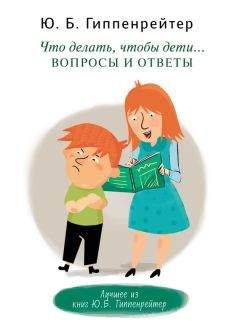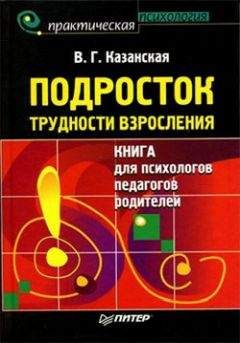Валерий Астапов - Тревожность у детей
Занятие 7 – повторение занятия 6.
Занятие 8 до завершения курса – самостоятельная релаксация, активация тревоги с последующей самостоятельно инициированной пациентом релаксацией при сохранении в сознании ситуации тревоги; чередование ситуаций тревоги с уровнем интенсивности 60 и 90.
Ситуации релаксации и тревоги записываются. В технике индивидуальной терапии АМТ при инициации ситуаций тревоги и релаксации терапевт описывает детали окружающей обстановки и детали, стимулирующие активацию тревоги. В связи с тем что у каждого пациента в группе детали ситуации тревоги отличаются, устная инструкция для группы становится невозможной. Вместо этого с каждым пациентом проводится индивидуальное собеседование с целью определения индивидуальных особенностей ситуации тревоги. Затем предлагается записать сформированную ситуацию тревоги на карточке. В данном случае, когда терапевт дает пациентам инструкцию переключиться на ситуацию тревоги, каждый из них понимает, что инструкция относится к ситуации тревоги, записанной на его индивидуальной карточке.
Сигнализация рукой имеет особое значение для получения важной информации. Например, если пациент не дает сигнала об активации тревоги, терапевт может сказать: «Если Вы смогли испытать переживание активации тревоги уровня интенсивности 60 во время визуализации последней сцены тревоги, дайте мне знак об этом поднятием правой руки». Сигнализация такого рода обеспечивает терапевту важность контролировать успешность каждого во время занятия.
В заключении необходимо отметить, что использование техники АМТ в больших группах неэффективно.
Литература
1. Блюм Г. Психоаналитические теории личности – М.: КСП, 1996.
2. Дельгадо Х. Мозг и сознание. – М., 1971.
3. Джемс У. Психология. – М.: Педагогика, 1991.
4. Кемпинский А. Экзистенциальная психиатрия. – М.: Изд-во «Совершенство», 1998.
5. Кьеркегор С. Страх и трепет: Пер. с дат. – М.: Республика, 1993.
6. Лазарус Р. Теория стресса и психофизиологические исследования. – В сб.: Эмоциональный стресс. – Л.: Медицина, 1970.
7. Марсон П. 25 ключевых книг по психоанализу: Пер. с фр. – Челябинск: «Урал LTD», 1999.
8. Раттер М. Помощь трудным детям: Пер. с англ./ Общ. ред. А.С. Спиваковской. – М.: Прогресс, 1987.
9. Рейковский Я. Экспериментальная психология эмоций. – М.: Прогресс, 1972.
10. Рикфорт Ч. Критический словарь психоанализа – СПб., 1995.
11. Роджерс К. Взгляд на психотерапию: Становление человека. – М.: Прогресс-Универс, 1994.
12. Стреляу Я. Роль темперамента в психическом развитии. – М.: Прогресс, 1982.
13. Тиллих П. Теология культуры. Пер. с англ. – М.: Юрист, 1995, 479с.
14. Фрейд А. Психология «Я» и защитные механизмы. – М., Педагогика, 1993.
15. Фрейд А. Теория и практика детского психоанализа. Пер. с англ. – М.: Апрель-Пресс. Издательство ЭКСМО-Пресс, 1999.
16. Фрейд З. Введение в психоанализ: Лекции. – М.: Наука, 1989.
17. Фромм Э. Анатомия человеческой деструктивности: Перевод – М.: Республика, 1994.
18. Хекхаузен Х. Мотивация и деятельность. Т.1 – М.: Педагогика, 1986.
19. Хорни К. Невротическая личность нашего времени; Самоанализ: пер. с англ. – М., Изд. группа «Прогресс» – «Универс», 1993.
20. Эриксон Э. Детство и общество. – СПб., 1996.
21. Юнг К. Архетип и символ. – М.: Ренессанс, 1991.
22. Юнг К. Собрание сочинений. Конфликты детской души. Пер. с нем. – М.: Канон, 1997.
23. Abramson L., Alloy L., Metalsky G. The cognitive diathesis – stress theories of depression: Toward and adequate evaluation of the theories’ validities. – In: L.Alloy (Ed.), Cognitive processes in depression. New York, 1988, pp. 3-30.
24. Achenbach T. Integrative guide for the 1991 CBCL/4-18, YSR, and TRF profiles. University of Vermont, 1991.
25. Achenbach T. The child behavior profile: I. Boys aged 6-11. – J. Consulting and Clinical Psychology, 1978, Vol. 46, pp. 478–488.
26. Achenbach T., Connors G., Quay H. e.a. Replication of empirically derived syndromes as a basis for taxonomy child/adolescent psychopathology. – J. of Abnorm. Child Psychol., 1989, Vol. 17, pp. 299–323.
27. Achenbach T., Edelbrock C. The child behavior profile: II. Boys aged 12–16 and girls aged 6-11 and 12–16. – J. Consulting and Clinical Psychology, 1979, Vol. 47, pp. 223–233.
28. Achenbach T., Howell C., Quay H., Conners C. National survey of competencies and problems among 4 to 16 year-olds: Parent’s reports for normative and clinical samples. – In: Monographs of the Society for Research in Child Development, 1991.
29. Ackerson L. Children’s behavior problems. Chicago University, 1931.
30. Ainsworth M. Individual Differences in strange-situation behavior of one year olds. In: H. Schaffer (Ed.), The Origins of Human Social Relations. Academic Press, London-New York, 1971, p.145.
31. Alder A. Uber den nervosen Charakter. Munchen, 1928.
32. Alloy L., Kelly K., Mineka S., Clements. Comorbidity of anxiety and depression disorders: A helplessness – hopelessness perspective. – In: J.Maser, C. Cloninger (Eds). Comorbidity of mood and anxiety disorders. Washington, 1990.
33. Allport G. Pattern and Growth in Personality. N-Y: Holt, Rinehart and Winston, 1961.
34. Allport G. The Individual and His Religion. New York: Macmillan, 1970.
35. Anthony S. The Discovery of Death in Childhood and After. Allen Cane, London, 1971.
36. Arnold M. Stress and Emotion. In: Psychological Stress – New York, 1967, pp. 123–130.
37. Ayllon T., Smith D., Rogers M. Behavioral management of school phobia. – J. Behav. Ther. Psychiatry, 1970, Vol. 1, pp. 125–138.
38. Bandura A. Social Learning Theory. Prentice-Hall, Englewood Cliff, New York, 1977.
39. Bandura A., Menlove F. Factors determining vicarious extinction of avoidance behavior through symbolic modeling. – J. Pern. and Soc. Psych., 1968, Vol. 5, pp. 16–23.
40. Barlow D. Anxiety and its disorders: The nature and treatment of anxiety and panic. New York, 1988.
41. Barrat E. Anxiety and impulsiveness: Towards a neuropsychological model. In Anxiety: Current Trends in Theory and Research / Ed. Ch. Spielberger – Vol. 1, New York – London, 1972, pp.195–222.
42. Basowitz H., Persky H., Korchin S. and Grinker R. Anxiety and Stress. New York: McGraw-Hill, 1955.
43. Basowitz M. Anxiety and stress. New York, 1955, 278 p.
44. Basowitz M., Persky H., Korchin S., Grinker R. Anxiety and stress. An Interdisciplinary Study of life situations – New York, 1955, pp.85 – 109.
45. Basselman B. Neurosis and psychosis. 3-ed., Springfield, 1964, pp. 11–13.
46. Beck A. Cognition, anxiety and psychophysiological disorders – In: Anxiety. Current trends in theory and research. Vol.2/ Ed. Ch.Spielberger – New York – London, 1972, p.343.
47. Beck A., Emery G. Anxiety disorders and phobias: A cognitive perspective. New York, 1985.
48. Beck A., Stewart B., Clark L. Cognitive specificity and positive-negative affectivity: Complementary or contradictory views on anxiety and depression? – J. of Abnorm. Psychology, 1990, Vol. 99, pp. 148–155.
49. Beidel D., Neal A., Lederer A. The feasibility and validity of a daily diary for the assessment of anxiety in children. – J. Behavior Therapy, 1991, Vol. 22, pp. 505–517.
50. Bender L. Anxiety in Disturbed Children. In Hoch, Paul H., and Zubin J. (Eds), Anxiety. N-Y, 1950.
51. Berge A. L’enfant an caractere dificile. Paris, Libraire Hachette, 1970.
52. Bieber I. A Concept of Psychopathology. Current Approaches to Psychoanalysis. Hoch P. and Zubin J. (Eds) – N-Y, 1960.
53. Blagg N. School phobia and its treatment. London, 1987.
54. Blan A., Huse W. Anxiety (“actual”) neuroses as a cause of behavior disorders. – Amer. J. Orthopsychiat, vol. 26, p.108, 1956.
55. Blau A. A unitary hypothesis of emotion: Anxiety, emotions of displeasure and affective disorders – J. Psychoanal. Quart, vol. 24, 1955, p.75.
56. Blumberg S., Izard C. Discriminating patterns of emotions in 10– and 11-year-old children’s anxiety and depression. – J. Personality and Social Psychology, 1986, Vol. 51, pp. 852–857.
57. Borkovec T., Hu S. The effect of worry on cardiovascular response to phobic image – J. Behav. Res. Ther., 1990, vol. 28, pp. 69–73.
58. Bower T. Development in Infancy. Freeman, San Francisco, 1974.
59. Bowlby J. Attachment and Loss Separation: Anxiety and Anger. New York, 1975, Vol. 11, pp. 454–489.
60. Bowlby J. Psychopathology of anxiety: The role of affectional bonds. In: M.Cader (Ed). Studies in Anxiety. R.M.P.A. Headley. Kent, 1969, pp. 96-108.
61. Bowlby J. Separation anxiety – Int. J. Psychoanal., 1960,vol. 41, p.89.
62. Bowlby J. The nature of the child’s tie to his mother. – Int. J. Psychoanal., 1951, Vol. 39, pp. 350–357.
63. Brown J. The motivation of behavior. New York: McGraw-Hill, 1950.
64. Brown T., Barlow D. Comorbidity among anxiety disorders: Implications for treatment and DSM-IY. – J. of Cons. and Clin. Psychology, 1992, Vol. 60, pp. 835–844.
65. Buss A. Two anxiety factors in psychiatric patients. – J. Abn. Soc. Psychol., 1962, vol. 62, p.426.
66. Campos J., Emde R., Gaenbauer T. and Henderson C. Cardiac and behavioral interrelationships in the reactions of infants to strangers. – J. Devel. Psychol., 1975, vol. 11, p. 589–601.
67. Cannon W. The James-Lange theory of emotion: A critical examination and an alternative theory. – Am. J. Psychol., 1927, Vol. 39, pp. 106–124.
68. Carron A. Reactions to “anxiety and motor behavior” – Journal of Motor Behav., 1971, Vol. 2, pp. 181–188.
69. Castaneda A., McCandless B., Palmero D. The children’s form of the Manifest Anxiety Scale. – J. Child Development, 1956, Vol. 16, pp. 317–326.
70. Cattell R. Anxiety and motivation: theory and critical experiments – In: Anxiety and behavior / Ed. Ch. Spielberger. New York – London, 1966, p.23.
71. Cattell R. Psychological definition and measurement of anxiety. – J. Neuropsychiat, 1964, vol.5, p.396.
72. Cattell R., Scheier I. The meaning and measurement of neuroticism and anxiety, New York: The Roland Press Company, 1961, p.2.
73. Clark D., Beck A. Cognitive theory and therapy of anxiety and depression. -In: P Kendall and D. Watson (Eds), Anxiety and depression: Distinctive and overlapping features. – San Diego, 1989, pp. 379–411.
74. Clark L. The anxiety and depressive disorders: Descriptive psychopathology and differential diagnosis. – In: P Kendall and D. Watson (Eds), Anxiety and depression: Distinctive and overlapping features. – San Diego, 1989, pp. 83-130.
75. Cloninger C. Anxiety and theories of emotions. – In: Handbook of Anxiety, Vol. 2, K. Noyes, M. Roth, G. Burrows (Eds), pp. 1-29, Amsterdam, 1988.
76. Costello A., Edelbrock C., Dulcan M., Kalas R., Klaric S. Report on the NIMN Diagnostic Interview Schedule for Children (DIS-C). Washington, National Institute for Mental Health, 1984.
77. Costello E., Angold A. – J. Amer. Acad. Child and Adolescent Psychiatry. 1988, Vol. 27, pp. 726–737.
78. Crosby J. Theories of Anxiety: a theoretical perspective – Am.J. Psychoanal., 1976, vol. 36, p.237.
79. Crowe R. The genetics of panic disorder and agoraphobia. – J. Psychiatric Developments, 1985, Vol. 2, pp. 171–186.
80. Dabrowski K. Spoleczno-wichowawcza psychiatrie dziecieca. Wyd. 2, Warczawa, PZWS, 1964.
81. De Ruiter, Rijken H., Garssen e.a. Comorbidity among the anxiety disorders. – J. of Anxiety Disorders, 1989, Vol. 3, pp. 57–68.
82. Dollard J., Miller N. Personality and psychotherapy. New York, McGraw-Hill, 1950.
83. Dowrick P. Self Modeling: A Videotape Training Technique for disturbed Children. University of Auckland, 1976.
84. Dowrick P. Suggestions for the use of edited video replay in training behavioral skills. – J. Practical Approaches to Dev. Handicap., 1978, Vol. 2, pp. 21–24.
85. Dowrick P., Raeburn J. Video editing and medication to produce a therapeutic self model. – J. Consulting and Clinical Psychology, 1977, Vol. 45, pp. 1156–1158.
86. Durand-Dassier J. Structure et psychilogie de relation. Paris, L’Epi, 1969.
87. Dweck C., Worthman C. Learned helplessness, anxiety and achievement. – In: H.Krone, L.Laux (Eds) Achievement, stress and anxiety. New York, 1982, pp. 93-125.
88. Endler N., Hunt J., Rosenstein A. An S-R inventory of anxiousness. – J. Psychol. Monogr., 1974, Vol. 76, pp. 145–162.
89. Epstein S. The nature of anxiety with emphasis upon its relationship to expectancy – In: Anxiety, current trends in thory and research, vol. 2 / Ed. Ch. Spielberger. New York – London, 1972, p.291.
90. Epstein S. Toward a unified theory of anxiety – In: Progress in Experimental Personality Research / Ed. B.Macher. – New York, 1967, pp. 1-87.
91. Evers W., Schwazz J. Modifying Social withdrawal in preschoolers: The effects of filmed modeling and teacher praise. – J. Abnorm. Child Psychology, 1973, Vol. 1, pp. 248–256.



